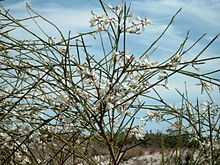Retama monosperma
From Wikipedia, the free encyclopedia
| Retama monosperma | |
|---|---|
 | |
| Scientific classification | |
| Kingdom: | Plantae |
| (unranked): | Angiosperms |
| (unranked): | Eudicots |
| (unranked): | Rosids |
| Order: | Fabales |
| Family: | Fabaceae |
| Subfamily: | Faboideae |
| Tribe: | Genisteae |
| Genus: | Retama |
| Species: | R. monosperma |
| Binomial name | |
| Retama monosperma (L.) Boiss. | |
| Subspecies | |
|
R. monosperma ssp. eumonosperma | |
| Synonyms | |
| |
Retama monosperma, the bridal veil broom, is a flowering bush species in the genus Retama.
R. monosperma forms root nodules with Sinorhizobium fredii. The larvae of the moths Phyllonorycter hesperiella and Phyllonorycter spartocytisi feed on R. monosperma.
The seeds contain cytisine, a toxic alkaloid. Fifteen other quinolizidine and three dipiperidine alkaloids can also be isolated from different parts of the plant. In particular, the presence of (+)-sparteine, α- and β-isosparteine, (+)-17-oxosparteine, (-)-lupanine, 5,6-dehydrolupanine, (-)-anagyrine, (-)-N-methylcytisine and (+)-ammodendrine can be detected.[1]
See also
References
External links
| Wikispecies has information related to: Retama monosperma |
| Wikimedia Commons has media related to Retama monosperma. |
This article is issued from Wikipedia. The text is available under the Creative Commons Attribution/Share Alike; additional terms may apply for the media files.